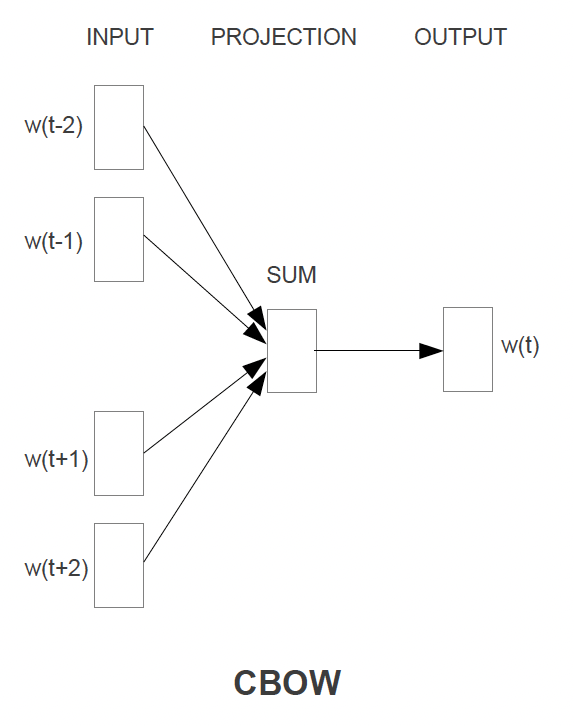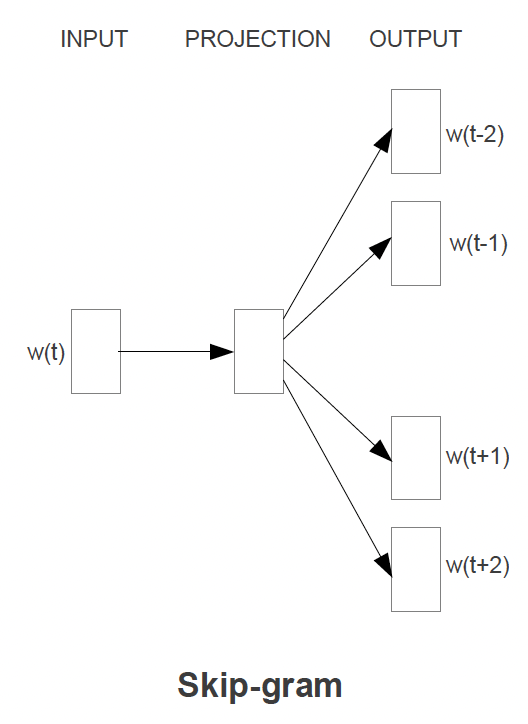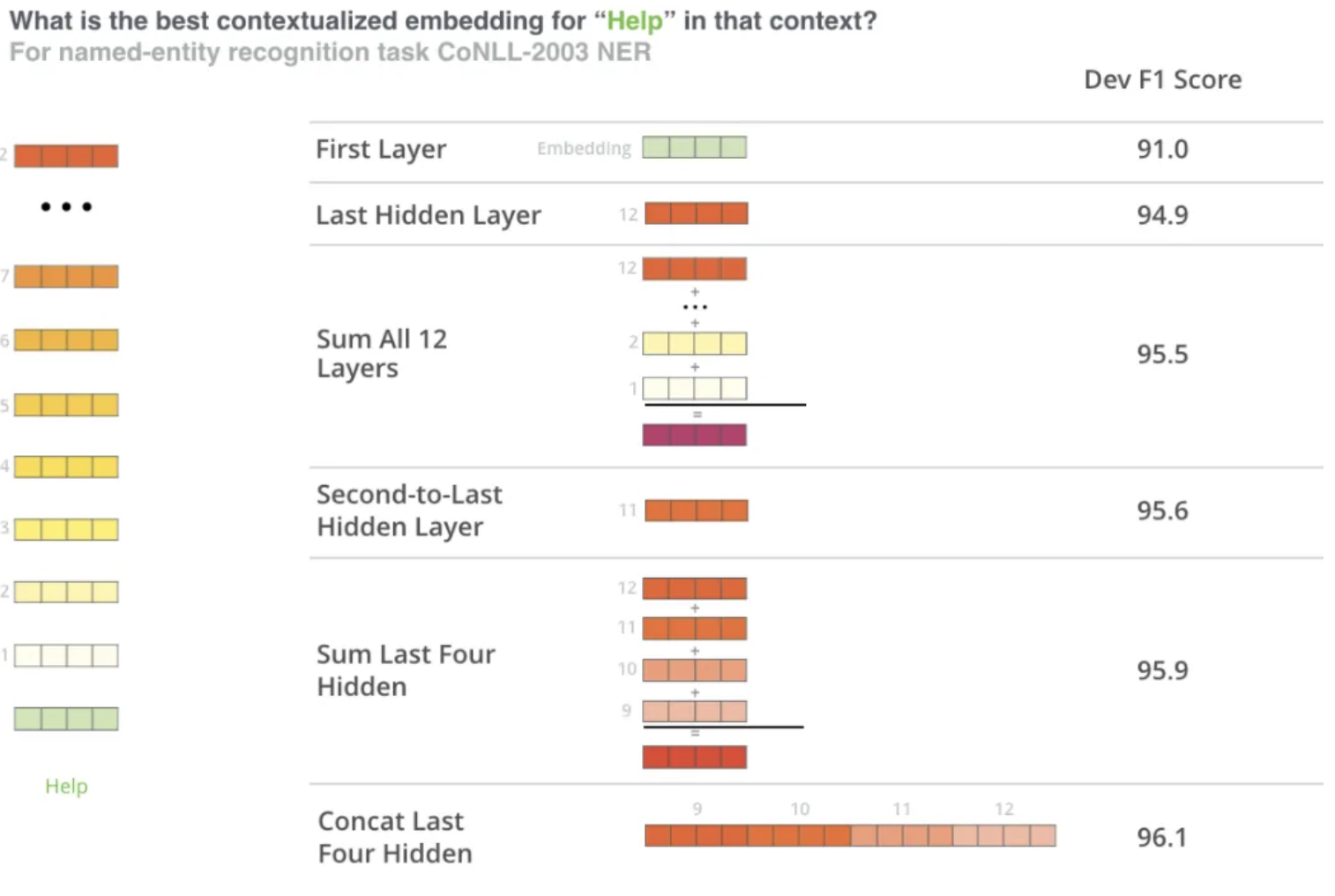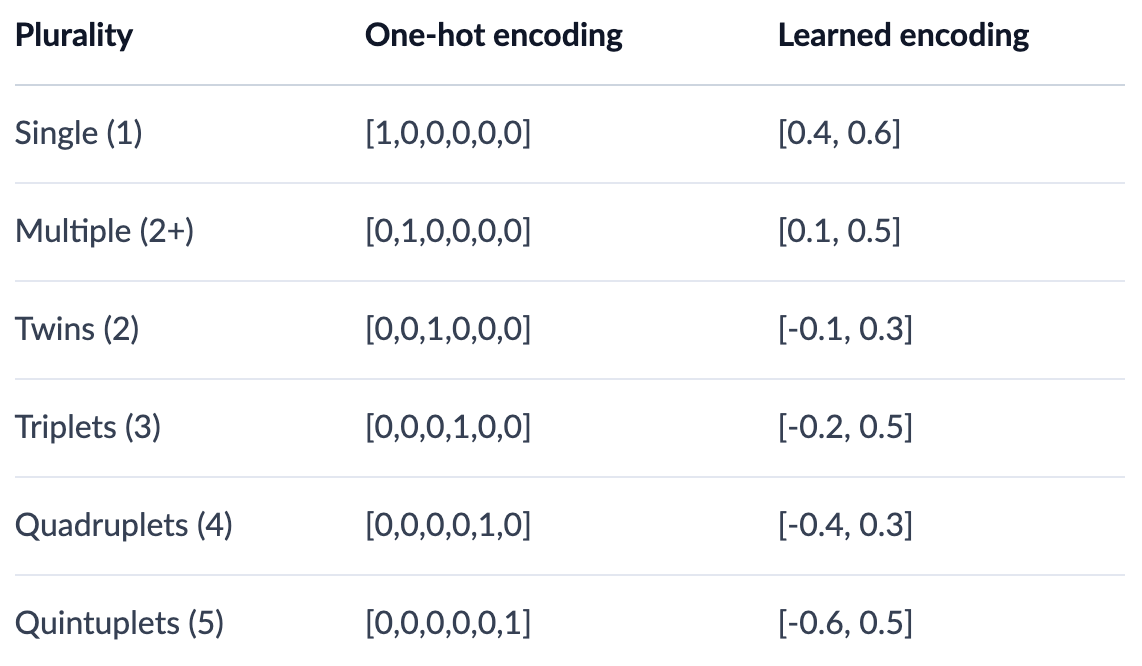Table of Contents
- Embeddings
- Text Embeddings
- User Embeddings
- Embeddings vs Autoencoder vs Variational Autoencoder
- Vector Similarities + Lookup
Embeddings
Embeddings are dense vector representations of objects - typically we use them for Documents, Queries, Users, Context, or Items...but they can really be used to represent anything
History
- In the past there have been many ways of creating embeddings
- Encoders
- One Hot Encoding: When we would replace categorical variables with vectors of sparse 0's and a single 1 representing the category
- Binary Encoders: Converts categorical variables into binary code - similar to One Hot Encoding, except we basically pick an ID that incrementally increases for new categories
- Collaborative Filtering is discussed later on
- Word2Vec
- Doc2Vec
- Node2Vec!
- etc...
Categorical Features
- One-Hot Encoding represents orthonormal basis of vectors, and typically is useful for categorical variables but becomes infeasible if we try to use it for text features
- Label Encoding is similar to One-Hot Encoding, except we use an incremental ID for each of the categories
Numeric Features
- This depends on the distribution of the data
- Standardization: Transforms the data to having a mean of zero, and a standard deviation of one
- This allows us to bring data in different distributions onto the same common scale
- Normalization: Brings the data to a specific range between
- This is helpful when you want to ensure all features contribute equally to the model
- When to use what?
- Standardization:
- Use when the features have different units or scales.
- Useful for algorithms that assume the data is normally distributed (e.g., linear regression, logistic regression, SVM).
- Helps in dealing with outliers.
- Normalization:
- Use when you want to scale the data to a specific range (e.g., [0, 1]).
- Useful for algorithms that do not assume any specific distribution of the data (e.g., k-nearest neighbors, neural networks).
- Ensures that all features contribute equally to the model.
- Standardization:
- Standardization: Transforms the data to having a mean of zero, and a standard deviation of one
- There are plenty of other ways to treat numeric data as features, but these are two easy and common ways
Text Embeddings
Text Embeddings are one of the harder things to figure out, but there are some standards nowadays
- Training Word2Vec and BERT both involved semi self-supervised training where they take online corpus as input and basically use contextual words to try and create an embedding for a current word
- Word2Vec was one of the original ideas for text embeddings - it essentially acts as an autoencoder to create static embeddings for each word in a dictionary
- BERT on the other hand, through attention, can create contextual embeddings for words, sentences, and entire documents
- GPT is an autoregressive transformer model in the same transformer "family" as BERT, but it is unidirectional where BERT is bidirectional (which is constantly repeated in the paper)
- GPT is good for text-to-text tasks like question answering, but like BERT we can pull from the middle hidden layers during it's self-attention steps to find word embeddings
Word2Vec
As we said above Word2Vec is essentially a static lookup of words to embeddings, and so Word2Vec is an embedding model
- Parameters:
- is context window size (input size)
- is the number of words in our dictionary
- is the embedding size (projection layer)
- is the current target word
Training and Output
- Word2Vec will use context words to help model a current word - this modeling is done without context (meaning position of other words is irrelevant) and we use words in the past and future
- When everything is finished, the weights of the shallow network are the actual embeddings themselves!
- There are 2 types of training tasks:
- Continuous Bag of Words where we use the context words as input and try to predict the current word
- Basically we divide context window in half in front and behind current word
- Skip Gram is where we use the current word as input to predict each one of the context words
- Continuous Bag of Words where we use the context words as input and try to predict the current word
- This allows us to have a static embedding representation of words
- Take the final projection layer of size and this is your word embedding matrix
Model Architecture
- Architecture:
- Overall the Time Complexity will be around the order of which gets reduced to with hierarchical softmax
- First layer of comes from taking local One-Hot Encoded Vectors, all of size and performing some calculations to get them to instances of size which is the size of our embedding
- Overall the Time Complexity will be around the order of which gets reduced to with hierarchical softmax
- Optimizations to training
- Negative Sampling where we pull a small number of negative examples along with the correct contextual examples
- Sub Sampling is similar to Negative Sampling TODO
- Hierarchical Softmax TODO
- Hierarchical Softmax allows us to only use memory and somehow time complexity in the last layer? Idrk - TODO
- Huffman Tree is actually a further optimization of Hierarchical Softmax
- which means it's even better than HSoftmax?
Continuous Bag of Words Architecture
- The CBOW architecture will use some surrounding context of words to predict the current word
- The context words get projected into hidden layer, and then they are basically all averaged
- This means there is no context involved, and that the surrounding words are simply averaged
- For the context words, past and future words are used
- In the paper with 4 before (historic), and 4 after (future)
- Training Objective: Predict the middle word from the surrounding context words
- Time Complexity: Would be
- General rule of thumb: Pluses separate layers, multiplication shows layer dimensions / work
- The output layer is a
log-linear classifier- TODO: Explain log-linear classification

Continuous Skip Gram Architecture
- The Skip Gram architecture will use the current word to predict some surrounding context of words
- The current word is sent through a
log-linear classifierinto a continuous projection layer, and then they projection layer is used to predict the best potential context words- This still! means there is no context involved, and that the surrounding words are simply predicted without specifying placement
- Training Objective: Predict some surrounding context words from the current word, and then pick, randomly, words from the context words
- Since more distant words are most likely more unrelated to the current word, we reduce computational complexity by sampling from those words less frequently
- There's no other way to give less weight to other "far away" words other than sampling them less and updating weights less often based on them
- Time Complexity: Would be
- For each of the words we need to take our input word , do multiplcations to get it into projection layer, and then go from our projection layer into our sized vocabulary to try and predict

Evaluation of Model
- In the past the main way to do this was to just show tables of words with their corresponding Top-K most similar other words, and intuitively check
- In the Word2Vec Paper they checked over relationships such as "What is the word that is similar to small in the same sense as bigger is to big"
- Ideally this would produce smaller
- This can be done with algebraic operations!
vector(big) - vector(bigger) + vector(small)would give us that sort of output, and then we just find the closest vector via Cosine Distance - There are other relationships to test such as France is to Paris as Germany is to Berlin
TODO: Is below correct? Semantic vs Syntactic...Semantic is "underlying meaning of words" and syntactic is "placement of word"?
- Skip Gram performed better on semantic objectives, which isn't surprising seeing as it's entirely focused on structuring a word to best represent what other words would be around it, so
AmericaandUnited Statesshould be similar - Bag of Words performed better on syntactic objectives showing how the CBOW model is better at syntax modeling where we could alter the sentence The quick brown fox jumped over the lazy river to Over the lazy river the quick brown fox had jumped
BERT
BERT architecture, training, and fine tuning is descirbed in another page, but given all of that is read through we discuss below how to get useful embeddings out of BERT!
Since BERT is an Encoder Only Model, it basically takes an input, runs it through multiple Encoders, and would send it through an output layer at the end - this output layer tyipcally isn't useful by itself for Word Embeddings, so we would need to go back through the hidden state values and aggregate these in some way to produce Word, Sentence, or Document embeddings
BERT Word Embeddings
- Another reference link
- Most use cases of word embeddings can come straight out of a pre-trained core BERT model
- We could send a single word through and it would most likely just be a representation of the WordPiece Embedding layer at the start
- If we send multiple words through (a sentence) then we could try and reconstruct each individual words new embedding that was altered from the self-attention layers
bankin the sentencethe large and sandy river bankwill be attended to, and ultimately different, fromthe countries central bankbecause it's surrounding context words are different!- Typically you would send through the sentence and then pull back each , or some mixture of hidden states, for each and that would represent your finalized word embedding that was attended to / altered from contextual self-attention!

BERT Embeddings Pseudo Code
- We'd need to load in the WordPiece Tokenizer
- Tokenize our sentence input into Word Pieces
- Will have some words get split into tokens like
embeddings -> [em, ###bed, ###ding, ###s]
- Will have some words get split into tokens like
- Load the pre-trained BERT model
- Set the model to
eval()mode since we do not want to go through updating the base models weights for inference time
- Set the model to
- Get the token ID's for each of these tokens from the pre-trained BERT state file
- Create a segement embedding (can just be repeated 0's and 1's of same size as token embeddings) which represent what sentence these tokens are apart of
- In this scenario to embed one sentence we will most likely just have all 0's in our segment embedding
- Pass the token and segment tensors through the BERT model
- It will output all of it's hidden layers - these include multiple dimensions:
- The layer number (13 layers)
- Input WordPiece embedding + 12 hidden layers
- The batch number (1 sentence)
- Used to batch together multiple sentences for inference, for now it's just 1
- The word / token number (22 tokens in our sentence)
- The hidden unit / feature number (768 features)
- The layer number (13 layers)
- Most people permute this output to get it in the order of
[# tokens, # layers, # features]- From this we have 13 separate vectors of size 768 for each token
- Once this is done we can just directly
SUM,CONCAT,AVG, etc...some mixture of hidden layers together to get our final word embedding - TODO: Why do the hidden states represent the word embeddings? These don't get updated for our words right? If we model an entire corpus why would sending
0, 1000, 4500through as a list of token ID's give us any sort of information? If I send through0, 1001, 4500are things that different even though I might be discussing a completely different word? - TODO: What do the hidden layers of a BERT model represent? They're optimized parameters for language modeling...how does that relate to word embeddings?
Why does this work?
- The embeddings start out in the first layer with 0 contextual representation in them -
river bankandcentral bankare the samebankembedding - As the embeddings move deeper and deeper into the network they pick up more contextual information
- As you approach the final layer you start to pick up information about the pre-trained BERTs tasks, MLM and NSP respectively
- BERT is setup well to encode information, but at the end of the day BERT is meant to predict missing words or next sentences
BERT Sentence Embeddings
- Taking the above example, the typical way to get sentence embeddings is to
SUMorAVGthe second to last hidden state for each token in the sentence to achieve a sentence embedding
User Embeddings
TODO: Outside of collab filtering, how do we get user embeddings? TLDR; How do we get meaningful representations of users?
Embeddings vs Autoencoder vs Variational Autoencoder
This question has come up in my own thoughts, and others have asked me - they all get to a relatively similar output of representing things into a compressed numeric format, but they all have different training objectives, use cases, and architectures - Autoencoders were created to reduce dimensionality, and Embeddings were created to represent, possibly dense items, into dense numeric representations
Embeddings
Description
- Embeddings are dense vector representations of objects (e.g., words, users, items) that capture their semantic or contextual meaning in a continuous vector space
- They are typically learned during the training of a neural network and can be static (pre-trained) or dynamic (contextual)
Use Cases
- Static Embeddings:
- Pre-trained embeddings like Word2Vec or GloVe are used for tasks where the context does not change (e.g., word similarity tasks)
- Example: Representing the word "bank" as a fixed vector regardless of its context
- Dynamic Embeddings:
- Contextual embeddings like BERT or GPT are used for tasks where the meaning of the object depends on its context
- Example: Representing "bank" differently in "river bank" vs. "central bank."
When to Use
- Use embeddings when you need a lightweight, efficient representation of objects for tasks like:
- Search and retrieval (e.g., cosine similarity between query and document embeddings)
- Recommendation systems (e.g., user-item embeddings)
- Pre-trained embeddings for transfer learning
Autoencoder
Description
- An Autoencoder is a type of neural network designed for dimensionality reduction. It learns to encode input data into a compressed representation (embedding) in the hidden layer and then reconstructs the original input from this representation
- It's typically used to represent sparse data into a more compact format
- The encoder compresses the input, and the decoder reconstructs it
- So what's the difference between an Autoencoder and Word2Vec?
- Word2Vec doesn't get train input word to be reconstructed on the other side (outright) like an Autoencoder, instead it tries to predict surrounding words...therefore the end results are ultimately the same, but the training tasks are different
Use Cases
- Dimensionality Reduction:
- Reducing high-dimensional data into a lower-dimensional embedding while preserving important features
- Example: Compressing image data for visualization or clustering
- Static Embeddings:
- The hidden layer of the Autoencoder can be used as a static embedding for the input data
- Example: Representing user profiles or item features in a recommendation system
When to Use
- Use Autoencoders when:
- You need static embeddings for structured data (e.g., tabular data, images)
- The input and output are the same, and you want to reduce dimensionality
- You do not need to generate new data points but only want a dense representation of existing data
Variational Autoencoder (VAE)
Description
- A Variational Autoencoder is an extension of the Autoencoder that introduces a probabilistic approach. Instead of encoding the input into a single deterministic vector, it encodes it into a distribution (mean and variance)
- The decoder samples from this distribution to reconstruct the input, allowing the generation of new data points
Use Cases
- Generative Models:
- VAEs are used to generate new data points similar to the training data
- Example: Generating new images, text, or user profiles
- Dynamic Embeddings:
- The latent space of the VAE can be used to create embeddings that capture uncertainty or variability in the data
- Example: Representing user preferences with variability for personalized recommendations
When to Use
- Use VAEs when:
- You need to generate new data points (e.g., synthetic data generation, data augmentation)
- You want embeddings that capture uncertainty or variability in the data
- The task involves probabilistic modeling (e.g., anomaly detection, generative tasks)
Comparison and When to Choose
| Technique | Static Embeddings | Dynamic Embeddings | Generative Tasks | Dimensionality Reduction |
|---|---|---|---|---|
| Embeddings | Yes | Yes | No | No |
| Autoencoder | Yes | No | No | Yes |
| Variational Autoencoder (VAE) | No | Yes | Yes | Yes |
| Word2Vec | Yes | No | No | No |
Key Considerations
-
Static vs. Dynamic Embeddings:
- Use Autoencoders or Word2Vec for static representations
- Use BERT or some sort of Transformer model with Attention for dynamic embeddings
-
Dimensionality Reduction:
- Use Autoencoders or VAEs when you need to reduce the dimensionality of high-dimensional data
-
Generative Tasks:
- Use VAEs when you need to generate new data points or capture variability in the data
-
Lightweight Models:
- Use Word2Vec for lightweight, static word embeddings
Vector Similarities + Lookup
Vector similarities are useful for comparing our final embeddings to others in search space
None of the below are actually useful in real life, as computing these for Top K is very inefficient - approximate Top K algorithms like Branch-and-Bound, Locality Sensitive Hashing, and FAISS clustering are used instead
Quantization
Quantization
- Definition: Quantization is a technique used to reduce the size of vector representations (e.g., embeddings) while preserving their ability to compare similarity effectively
- How It Works:
- It reduces the precision of the numerical values in the vector (e.g., from 32-bit floating-point to 8-bit integers)
- This compression reduces memory usage and speeds up computations, especially for large-scale systems.
- Key Idea:
- The goal is to maintain the relative distances or similarities between vectors in the embedding space, even after reducing their size
- Use Cases:
- Approximate Nearest Neighbor Search: Quantized vectors are often used in libraries like FAISS to perform fast similarity searches
- Edge Devices: Quantization is used to deploy machine learning models on devices with limited memory and computational power (e.g., mobile phones, IoT devices)
- Limitations:
- Quantization introduces some loss of precision, which can slightly affect the accuracy of similarity comparisons
Sketching
TODO:
Feature Multiplexing
TODO:
Cosine
Cosine similarity will ultimately find the angle between 2 vectors
- Where
- is the dot product of vectors and .
- and are the magnitudes (or Euclidean norms) of vectors and
- Therefore, magnitude has no effect on our measurement, and we only check angle between vectors
- Cosine similarity ranges from where:
- 1 indicates they're overlapping and pointing in the exact same direction
- 0 indicates they're fully orthonormal (right angle) with 0 overlap over any dimensions
- -1 indicates they're pointing in exactly opposite directions
Dot
The Dot product is similar to the Cosine product, except it doens't ignore the magnitude
Which basically means we just compare each item over each dimension. If are normalized then Dot is equivalent to Cosine
Euclidean
This is the typical distance in euclidean space
Here magnitude matters, and a smaller distance between vector end-points means a smaller overall distance metric
Topological Interpretations
Most of this comes from Yuan Meng Embeddings Post
There we see discussions of how embeddings, topologically, can be considered a injective one-to-one mapping that preserves properties of both metric spaces
We can also see that from a ML lense, embeddings represent dense numeric features in n-dimensional space
- Images can go to
3 colors x 256 pixelsdimension using photo represenation on disk (this is just how photos are stored) - Text can go from sentences to
256 dimensionvectors in Word2Vec or BERT - Text can go from address sentences to
[lat, long]2 dimensions - we cover this in Address Embeddings
The main point of all of this is that Embeddings equate to → topological properties are preserved - that's what allows the famous King - man + woman = Queen and France is to Paris as Germany is to Berlin
A random list of numbers is a numeric representation, but they are not Embeddings
One-hot encoding, kindof, preserves topolological properties, but all of the vectors end up being orthogonal to each other so we can't say category1 + category2 = 0.5category3...they're orthogonal! Typically we need to map these from OHE metric space to a lower dimensional metric space to get those properties out of it
